Wildlife-Vehicle Collisions as a Threat to Vertebrate Conservation in a Southeastern Mexico Road Network
Simple Summary
Abstract
1. Introduction
2. Materials and Methods
2.1. Study Area
2.2. Data Collection
2.3. Roadkill Rates and Kernel Density Estimations
2.4. Roadkill Rate Variations
2.5. Computation of Continuous Variables
2.6. Principal Component Analysis (PCA)
2.7. Generalized Additive Models (GAM)
3. Results
3.1. Roadkill Patterns
3.2. Wildlife Mortality Rates and Hotspot Identification via KDE
3.3. Variation in Roadkill Rates: Influence of Road Type, Faunal Group, and Land Cover
3.4. Dimensionality Reduction via PCA
4. Discussion
5. Conclusions
Supplementary Materials
Author Contributions
Funding
Institutional Review Board Statement
Informed Consent Statement
Data Availability Statement
Acknowledgments
Conflicts of Interest
Abbreviations
| CITES | Convention on International Trade in Endangered Species of Wild Fauna and Flora |
| CONABIO | Comisión Nacional para el Conocimiento y Uso de la Biodiversidad |
| GAM | Generalized Additive Models |
| GEE | Google Earth Engine |
| IUCN | International Union for Conservation of Nature |
| KDE | Kernel Density Estimation |
| NDVI | Normalized Difference Vegetation Index |
| PCA | Principal Component Analysis |
| RK/day | Roadkills per day |
| RK/month | Roadkills per month |
| RK/km | Roadkills per kilometer |
| RMSE | Root Mean Squared Error |
| SRTM | Shuttle Radar Topography Mission |
| UBRE | Un-Biased Risk Estimator |
| WVCs | Wildlife-vehicle collisions |
References
- Schwartz, A.; Shilling, F.; Perkins, S. The value of monitoring wildlife roadkill. Eur. J. Wildl. Res. 2020, 66, 18. [Google Scholar] [CrossRef]
- Silva, I.; Crane, M.; Savini, T. The road less traveled: Addressing reproducibility and conservation priorities of wildlife-vehicle collision studies in tropical and subtropical regions. Glob. Ecol. Conserv. 2021, 27, e01584. [Google Scholar] [CrossRef]
- Bíl, M.; Andrášik, R.; Cícha, V.; Arnon, A.; Kruuse, M.; Langbein, J.; Seiler, A. COVID-19 related travel restrictions prevented numerous wildlife deaths on roads: A comparative analysis of results from 11 countries. Biol. Conserv. 2021, 256, 109076. [Google Scholar] [CrossRef] [PubMed]
- Litvaitis, J.A.; Tash, J.P. An approach toward understanding wildlife-vehicle collisions. Environ. Manag. 2008, 42, 688–697. [Google Scholar] [CrossRef] [PubMed]
- Bennett, V.J. Effects of Road Density and Pattern on the Conservation of Species and Biodiversity. Curr. Landsc. Ecol. Rep. 2017, 2, 1–11. [Google Scholar] [CrossRef]
- Balčiauskas, L.; Kučas, A.; Balčiauskienė, L. The impact of roadkill on cervid populations in Lithuania. Forests 2023, 14, 1224. [Google Scholar] [CrossRef]
- Arroyave, M.D.P.; Gómez, C.; Gutiérrez, M.E.; Múnera, D.P.; Zapata, P.A.; Vergara, I.C.; Ramos, K.C. Impactos de las carreteras sobre la fauna silvestre y sus principales medidas de manejo. Rev. EIA 2006, 5, 45–57. [Google Scholar]
- Monge-Nájera, J. Road kills in tropical ecosystems: A review with recommendations for mitigation and for new research. Rev. Biol. Trop. 2018, 66, 722–738. [Google Scholar] [CrossRef]
- Pinto, F.A.; Clevenger, A.P.; Grilo, C. Effects of roads on terrestrial vertebrate species in Latin America. Environ. Impact Assess. Rev. 2020, 81, 106337. [Google Scholar] [CrossRef]
- Medrano-Vizcaíno, P.; Grilo, C.; Brito-Zapata, D.; González-Suárez, M. Landscape and road features linked to wildlife mortality in the Amazon. Biodivers. Conserv. 2023, 32, 4337–4352. [Google Scholar] [CrossRef]
- Cullen, L.; Stanton, J.; Lima, F.; Uezu, A.; Perilli, M.; Akçakaya, H. Implications of fine-grained habitat fragmentation and road mortality for jaguar conservation in the Atlantic Forest, Brazil. PLoS ONE 2016, 11, e0167372. [Google Scholar] [CrossRef] [PubMed]
- González-Gallina, A.; Hidalgo-Mihart, M.G. A review of road-killed felids in Mexico. Therya 2018, 9, 147–159. [Google Scholar] [CrossRef]
- Canales-Delgadillo, J.; Pérez-Ceballos, R.; Zaldívar-Jiménez, A.; Gómez-Ponce, M.; Vázquez-Pérez, N.; Rosa, M.D.L.; Potenciano-Morales, L. Muertes por tráfico sobre la carretera costera del golfo de México: ¿cuántas y cuáles especies de fauna silvestre se están perdiendo? Rev. Mex. Biodivers. 2020, 91, 913189. [Google Scholar] [CrossRef]
- Felder, D.L.; Camp, D.K. (Eds.) Gulf of Mexico Origin, Waters, and Biota: Biodiversity; Texas A&M University Press: College Station, TX, USA, 2009. [Google Scholar]
- Engle, V.D. Estimating the provision of ecosystem services by Gulf of Mexico coastal wetlands. Wetlands 2011, 31, 179–193. [Google Scholar] [CrossRef]
- Navarro-Sigüenza, A.G.; Rebón-Gallardo, M.F.; Gordillo-Martínez, A.; Townsend Peterson, A.; Berlanga-García, H.; Sánchez-González, L.A. Biodiversidad de aves en México. Rev. Mex. Biodivers. 2014, 85, S476–S495. [Google Scholar] [CrossRef]
- Cohen, E.B.; Barrow, W.C., Jr.; Buler, J.J.; Deppe, J.L.; Farnsworth, A.; Marra, P.P.; Moore, F.R. How do en route events around the Gulf of Mexico influence migratory landbird populations? Condor Ornithol. Appl. 2017, 119, 327–343. [Google Scholar] [CrossRef]
- Liceaga-Correa, M.; Uribe-Martínez, A.; Cuevas, E. Ecological vulnerability of adult female marine turtles as indicators of opportunities for regional socioecosystem management in the southern gulf of mexico. Sustainability 2021, 14, 184. [Google Scholar] [CrossRef]
- Pozo-Montuy, G.; Bonilla-Sánchez, Y.M. Population decline of an endangered primate resulting from the impact of a road in the Catazajá wetlands, Chiapas, México. Therya Notes 2022, 3, 75–81. [Google Scholar] [CrossRef]
- García-Sánchez, S.; Juárez-Agis, A.; Alvarez-Alvarez, E.A.; Salome, B.O.; Zeferino-Torres, J.; Rivas-González, M.; Osorio-Rodriguez, A.N. Wild vertebrates’ roadkill across human settlements of the Mexican Southern Pacific. Rev. Biol. Trop. 2023, 71, e53600. [Google Scholar]
- Pinto, C.M.; Soto, J.S.V.; Flatt, E.; Barboza, K.; Whitworth, A. Identifying wildlife road crossing mitigation sites using a multi-data approach—A case study from southwestern Costa Rica. J. Environ. Manag. 2024, 361, 121263. [Google Scholar] [CrossRef]
- Neumann, W.; Ericsson, G.; Dettki, H.; Bunnefeld, N.; Keuler, N.S.; Helmers, D.P.; Radeloff, V.C. Difference in spatiotemporal patterns of wildlife road-crossings and wildlife-vehicle collisions. Biol. Conserv. 2012, 145, 70–78. [Google Scholar] [CrossRef]
- Abraham, J.O.; Mumma, M.A. Elevated wildlife-vehicle collision rates during the COVID-19 pandemic. Sci. Rep. 2021, 11, 20391. [Google Scholar] [CrossRef] [PubMed]
- Coffin, A.W. From roadkill to road ecology: A review of the ecological effects of roads. J. Transp. Geogr. 2007, 15, 396–406. [Google Scholar] [CrossRef]
- Gunson, K.E.; Mountrakis, G.; Quackenbush, L.J. Spatial wildlife-vehicle collision models: A review of current work and its application to transportation mitigation projects. J. Environ. Manag. 2011, 92, 1074–1082. [Google Scholar] [CrossRef] [PubMed]
- D’Amico, M.; Périquet, S.; Román, J.; Revilla, E. Road avoidance responses determine the impact of heterogeneous road networks at a regional scale. J. Appl. Ecol. 2016, 53, 181–190. [Google Scholar] [CrossRef]
- Colino-Rabanal, V.J.; Lizana, M. Herpetofauna and roads: A review. Basic Appl. Herpetol. 2012, 26, 5–31. [Google Scholar] [CrossRef]
- Torres, A.; Palacín, C.; Seoane, J.; Alonso, J.C. Assessing the effects of a highway on a threatened species using Before-During-After and Before-During-After-Control-Impact designs. Biol. Conserv. 2011, 144, 2223–2232. [Google Scholar] [CrossRef]
- Ramírez, M.I.; Miranda, R.; Zubieta, R.; Jiménez, M. Land cover and road network map for the Monarch Butterfly Biosphere Reserve in Mexico, 2003. J. Maps 2007, 3, 181–190. [Google Scholar] [CrossRef]
- Fahrig, L.; Rytwinski, T. Effects of roads on animal abundance: An empirical review and synthesis. Ecol. Soc. 2009, 14, 21. Available online: https://www.jstor.org/stable/26268057 (accessed on 15 February 2020). [CrossRef]
- Cervantes-Huerta, R.; Escobar, F.; García-Chávez, J.H.; González-Romero, A. Atropellamiento de vertebrados en tres tipos de carretera de la región montañosa central de Veracruz, México. Acta Zool. Mex. 2017, 33, 472–481. [Google Scholar] [CrossRef]
- Köppen, W. Klassifikation der Klimate nach Temperatur, Niederschlag und Jahresablauf. Petermanns Geogr. Mitt. 1918, 64, 193–203, 243–248. Available online: https://commons.wikimedia.org/wiki/File:Klassifikation_der_Klimate_nach_Temperatur,_Niederschlag_und_Jahreslauf_(1918).pdf (accessed on 15 February 2020).
- Stoddart, D.M. (Ed.) Ecology of Small Mammals; Springer Science & Business Media: Berlin/Heidelberg, Germany, 2012. [Google Scholar]
- Ascensão, F.; LaPoint, S.; van der Ree, R. Roads, traffic and verges: Big problems and big opportunities for small mammals. In Handbook of Road Ecology; Wiley Online Library: Hoboken, NJ, USA, 2015; pp. 325–333. [Google Scholar]
- Boonstra, R.; Krebs, C.J.; Reid, D.G. Studying small mammal population dynamics: Advice to consider and pitfalls to avoid-a 60-year overview. Can. J. Zool. 2025, 103, 1–12. [Google Scholar] [CrossRef]
- Nagy-Reis, M.B.; Estevo, C.A.; Setz, E.Z.F.; Ribeiro, M.C.; Chiarello, A.G.; Nichols, J.D. Relative importance of anthropogenic landscape characteristics for Neotropical frugivores at multiple scales. Anim. Conserv. 2017, 20, 520–531. [Google Scholar] [CrossRef]
- Boggie, M.A.; Collins, D.P.; Donnelly, J.P.; Carleton, S.A. Land use, anthropogenic disturbance, and riverine features drive patterns of habitat selection by a wintering waterbird in a semi-arid environment. PLoS ONE 2018, 13, e0206222. [Google Scholar] [CrossRef] [PubMed]
- Williams, J.J.; Freeman, R.; Spooner, F.; Newbold, T. Vertebrate population trends are influenced by interactions between land use, climatic position, habitat loss and climate change. Glob. Change Biol. 2022, 28, 797–815. [Google Scholar] [CrossRef]
- Steyaert, S.M.; Zedrosser, A.; Elfström, M.; Ordiz, A.; Leclerc, M.; Frank, S.C.; Swenson, J.E. Ecological implications from spatial patterns in human-caused brown bear mortality. Wildl. Biol. 2016, 22, 144–152. [Google Scholar] [CrossRef]
- Lewis, J.S.; Spaulding, S.; Swanson, H.; Keeley, W.; Gramza, A.R.; VandeWoude, S.; Crooks, K.R. Human activity influences wildlife populations and activity patterns: Implications for spatial and temporal refuges. Ecosphere 2021, 12, e03487. [Google Scholar] [CrossRef]
- Chyn, K.; Lin, T.E.; Wilkinson, D.P.; Tracy, J.L.; Lawing, A.M.; Fitzgerald, L.A. Fine-scale roadkill risk models: Understanding the intersection of wildlife and roads. Biodivers. Conserv. 2021, 30, 139–164. [Google Scholar] [CrossRef]
- Kent, E.; Schwartz, A.L.; Perkins, S.E. Life in the fast lane: Roadkill risk along an urban–rural gradient. J. Urban Ecol. 2021, 7, juaa039. [Google Scholar] [CrossRef]
- Lombardi, J.V.; Yamashita, T.J.; Blackburn, A.; Young Jr, J.H.; Tewes, M.E.; Anderson, C.J. Examining the spatial structure of woody cover within a highway road effect zone for ocelots in Texas. Urban Ecosyst. 2023, 26, 1057–1069. [Google Scholar] [CrossRef]
- Yamashita, T.J.; Perotto-Baldivieso, H.L.; Wester, D.B.; Ryer, K.W.; Kline, R.J.; Tewes, M.E.; Lombardi, J.V. A multivariate approach to assessing landscape structure effects on wildlife crossing structure use. Ecol. Process. 2024, 13, 76. [Google Scholar] [CrossRef]
- Kolb, M.; Cruz-Cano, R.; Saldaña-Vázquez, R.A. Atropellamientos de vertebrados terrestres en carreteras: Los vacíos cuantitativos para el neotrópico. Acta Zoológica Mex. (NS) 2025, 41, 1–35. [Google Scholar] [CrossRef]
- Ríos-Solís, J.A.; Lavariega, M.C.; Flores-Martínez, J.J.; Sanchez, V.; Pech-Canché, J.M. Roadkills on medium-sized mammals in a tropical region in southern Mexico. SSRN 2024. [Google Scholar] [CrossRef]
- Ruíz-Ramírez, L.; González-Gallina, A.; Soto, V.; Pacheco-Figueroa, C.J.; Pech-Canché, J.M. Comparison of road-killed mammals on roads of different types of jurisdictions and traffic volume in Veracruz, México. Therya Notes 2022, 3, 82–86. [Google Scholar] [CrossRef]
- Cervantes-Huerta, R.; Durán-Antonio, J. Seasonal variation of mammal roadkill hotspots in the Sierra Madre Occidental, México. Therya Notes 2022, 3, 70–74. [Google Scholar] [CrossRef]
- Rubio-Rocha, Y.; Gaxiola-Camacho, S.; Morales-García, M.; Artigas-Gutiérrez, B.; Sánchez-Ríos, A.; Carvajal-Sauceda, F.; Espinoza-Evans, G. First records of road-killed mammals in the state of Sinaloa, México. Therya Notes 2022, 3, 53–58. [Google Scholar] [CrossRef]
- Rubio-Rocha, Y.; Chávez-Tovar, C.; Gaxiola-Camacho, S.; Ayala-Rubio, M.; Alvarado-Hidalgo, D.; Pérez-Camacho, A.; Sicairos-López, J. Impact of the roadkill of a jaguar cub (Panthera onca) on social networks and the inhabitants of Sinaloa, México. Therya Notes 2022, 3, 92–97. [Google Scholar] [CrossRef]
- Zarco-González, Z.; Carrera-Treviño, R.; Monroy-Vilchis, O. Conservation of black bear (Ursus americanus) in Mexico through GPS tracking: Crossing and roadkill sites. Wildl. Res. 2023, 51, WR22121. [Google Scholar] [CrossRef]
- Zarco-González, Z.; Monroy-Vilchis, O. Roadkill risk model of black bear (Ursus americanus) in Mexico. Environ. Monit. Assess. 2024, 196, 89. [Google Scholar] [CrossRef]
- Pacheco-Figueroa, C.J.; de Dios Valdez-Leal, J.; Cervantes, F.A.; del Carmen Luna-Ruíz, R.; Mata-Zayas, E.E.; Saenz, J.C. Documentation of a road-killed spectral bat (Vampyrum spectrum) and first report of the species in Tabasco, México. Therya Notes 2022, 3, 98–103. [Google Scholar] [CrossRef]
- Delgado-Trejo, C.; Herrera-Robledo, R.; Martínez-Hernández, N.; Bedolla-Ochoa, C.; Hart, C.E.; Alvarado-Díaz, J.; Mendoza, E. Vehicular impact as a source of wildlife mortality in the Western Pacific Coast of Mexico. Rev. Mex. Biodivers. 2018, 89, 1234–1244. [Google Scholar] [CrossRef]
- Canal, D.; Camacho, C.; Martín, B.; de Lucas, M.; Ferrer, M. Fine-scale determinants of vertebrate roadkills across a biodiversity hotspot in Southern Spain. Biodivers. Conserv. 2019, 28, 3239–3256. [Google Scholar] [CrossRef]
- Bristow, C.A. Effects of Road Characteristics, Land Cover, and Topography on Roadkill Patterns Across a Rural-Urban Gradient in Southwest Virginia. Ph.D. Thesis, Virginia Tech, Blacksburg, VA, USA, 2023. [Google Scholar]
- Seo, C.; Thorne, J.H.; Choi, T.; Kwon, H.; Park, C.H. Disentangling roadkill: The influence of landscape and season on cumulative vertebrate mortality in South Korea. Landsc. Ecol. Eng. 2015, 11, 87–99. [Google Scholar] [CrossRef]
- Cuyckens, G.A.E.; Mochi, L.S.; Vallejos, M.; Perovic, P.G.; Biganzoli, F. Patterns and composition of road-killed wildlife in northwest Argentina. Environ. Manag. 2016, 58, 810–820. [Google Scholar] [CrossRef]
- Beatty, W.S.; Beasley, J.C.; Olson, Z.H.; Rhodes, O.E., Jr. Influence of habitat attributes on density of Virginia opossums (Didelphis virginiana) in agricultural ecosystems. Can. J. Zool. 2016, 94, 411–419. [Google Scholar] [CrossRef]
- Walsh, L.L.; Tucker, P.K. Evaluating anthropogenic influence on a mesopredator: Opossum (Didelphis virginiana) isotope values influenced by corn agriculture more than urbanization. Can. J. Zool. 2023, 101, 307–316. [Google Scholar] [CrossRef]
- Demeny, K.; McLoon, M.; Winesett, B.; Fastner, J.; Hammerer, E.; Pauli, J.N. Food subsidies of raccoons (Procyon lotor) in anthropogenic landscapes. Can. J. Zool. 2019, 97, 654–657. [Google Scholar] [CrossRef]
- Lala, F.; Chiyo, P.I.; Kanga, E.; Omondi, P.; Ngene, S.; Severud, W.J.; Bump, J. Wildlife roadkill in the Tsavo Ecosystem, Kenya: Identifying hotspots, potential drivers, and affected species. Heliyon 2021, 7, e06364. [Google Scholar] [CrossRef]
- Obando-Tobón, J.M.; Urrego-Giraldo, L.E.; Saravia-Ruiz, P.; Arias-Alzate, A. Influence of behavior and habitat on wildlife roadkill: The case of vertebrates on peri-urban roads in the Colombian Andes. Rev. Biol. Trop. 2024, 72, e56433. [Google Scholar]
- Hill, J.E.; DeVault, T.L.; Belant, J.L. A review of ecological factors promoting road use by mammals. Mammal Rev. 2021, 51, 214–227. [Google Scholar] [CrossRef]
- Oddone Aquino, A.G.H.E.; Nkomo, S.P.L. Spatio-temporal patterns and consequences of road kills: A review. Animals 2021, 11, 799. [Google Scholar] [CrossRef] [PubMed]
- Kreling, S.E.; Gaynor, K.M.; Coon, C.A. Roadkill distribution at the wildland-urban interface. J. Wildl. Manag. 2019, 83, 1427–1436. [Google Scholar] [CrossRef]
- Valerio, F.; Basile, M.; Balestrieri, R. The identification of wildlife-vehicle collision hotspots: Citizen science reveals spatial and temporal patterns. Ecol. Process. 2021, 10, 6. [Google Scholar] [CrossRef]
- García Quintanilla, A.; López Barreto, M.F.; Espadas-Manrique, C.; Cach-Pérez, M.J.; Caballero Vázquez, J.A.; Zepeda, C.H. Impact of the Tren Maya Megaproject on the Biocultural Heritage of the Mayan Area in Mexico’s Best Conserved Tropical Forest. Int. J. Environ. Sci. Nat. Resour. 2022, 31, 556317. [Google Scholar] [CrossRef]
- López González, C.A.; Cruz Torres, F.; Hidalgo Mihart, M.G. Female puma (Puma concolor) highway crossings in the Yucatan Peninsula. West. N. Am. Nat. 2021, 80, 19. [Google Scholar] [CrossRef]
- Arca-Rubio, J.; Moreno-Rueda, G.; Ortega, Z. The distribution of vertebrate roadkill varies by season, surrounding environment, and animal class. Eur. J. Wildl. Res. 2023, 69, 42. [Google Scholar] [CrossRef]
- Blais, B.R.; Shaw, C.J.; Brocka, C.W.; Johnson, S.L.; Lauger, K.K. Anthropogenic, environmental and temporal associations with vertebrate road mortality in a wildland–urban interface of a biodiverse desert ecoregion. R. Soc. Open Sci. 2024, 11, 240439. [Google Scholar] [CrossRef]
- Filius, J.; van der Hoek, Y.; Jarrín-V, P.; van Hooft, P. Wildlife roadkill patterns in a fragmented landscape of the Western Amazon. Ecol. Evol. 2020, 10, 6623–6635. [Google Scholar] [CrossRef]
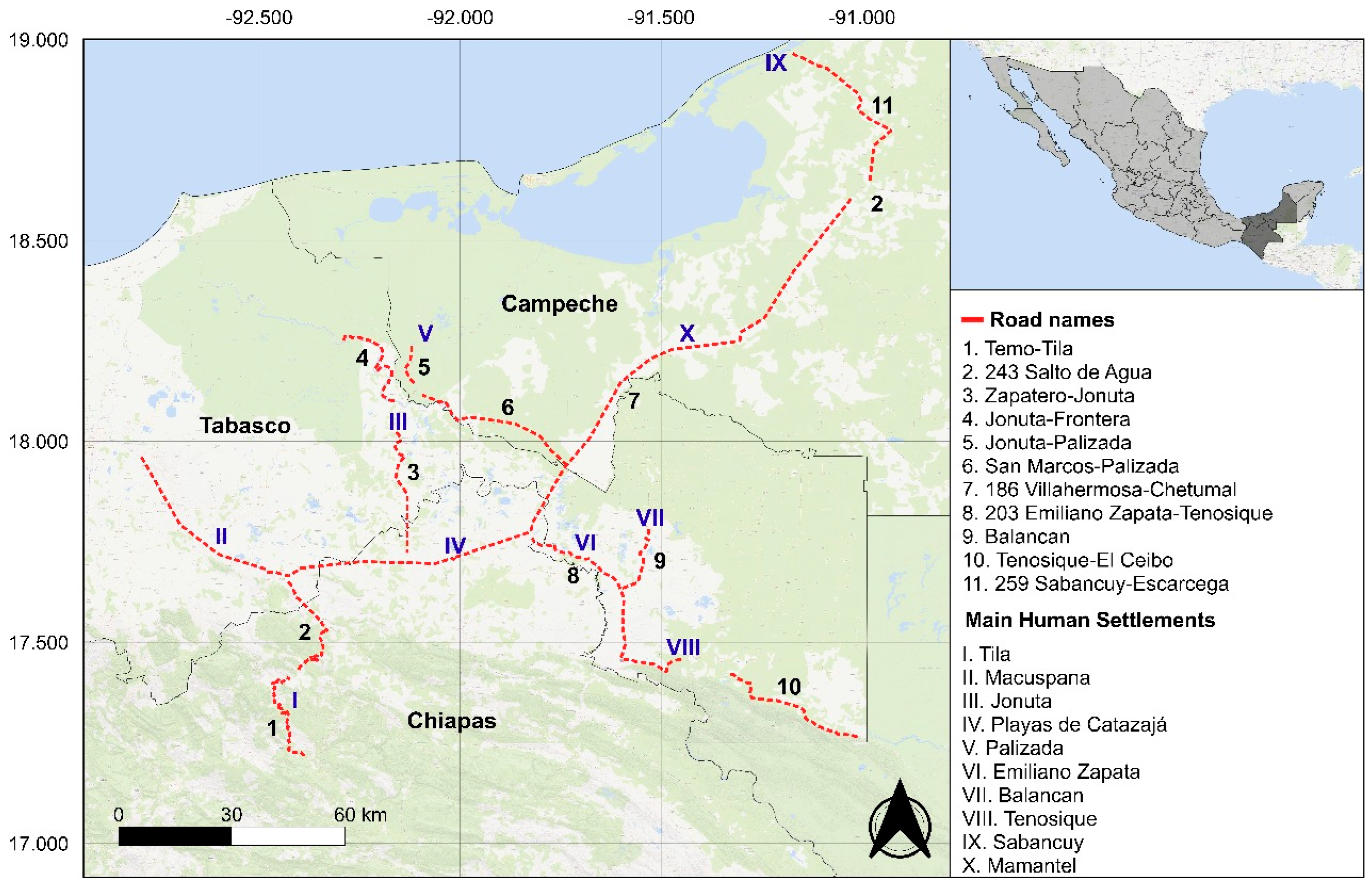
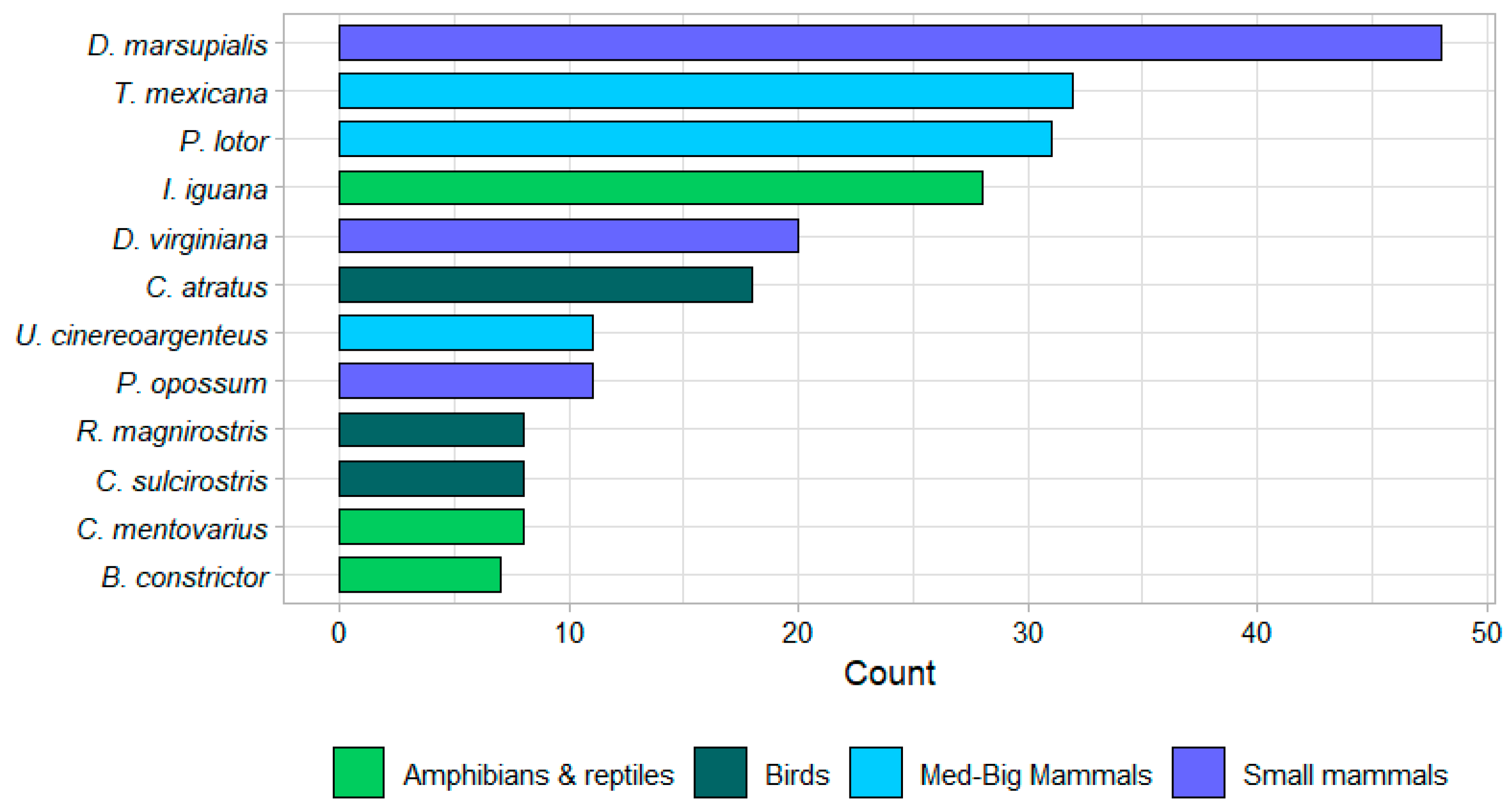
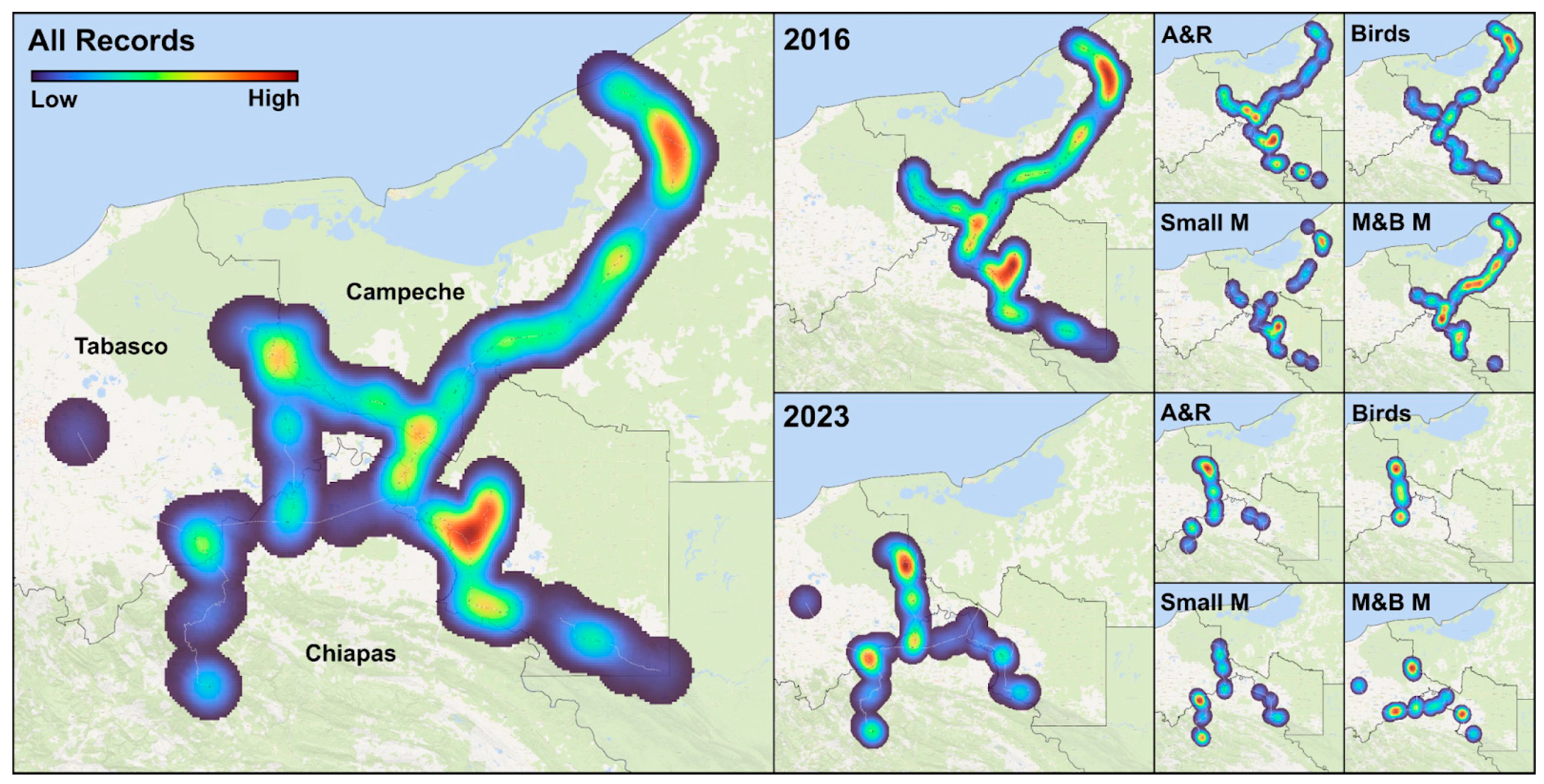
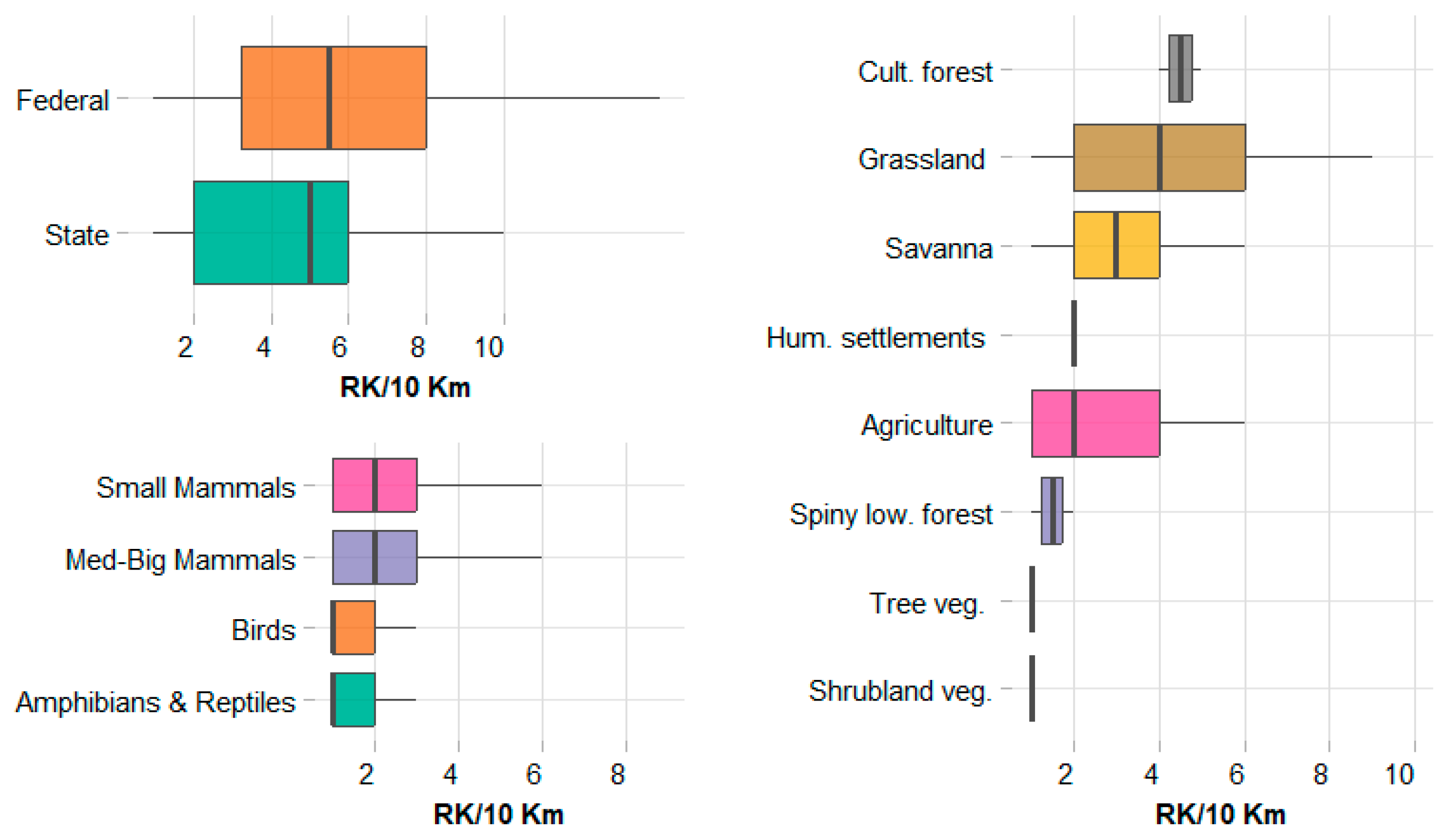
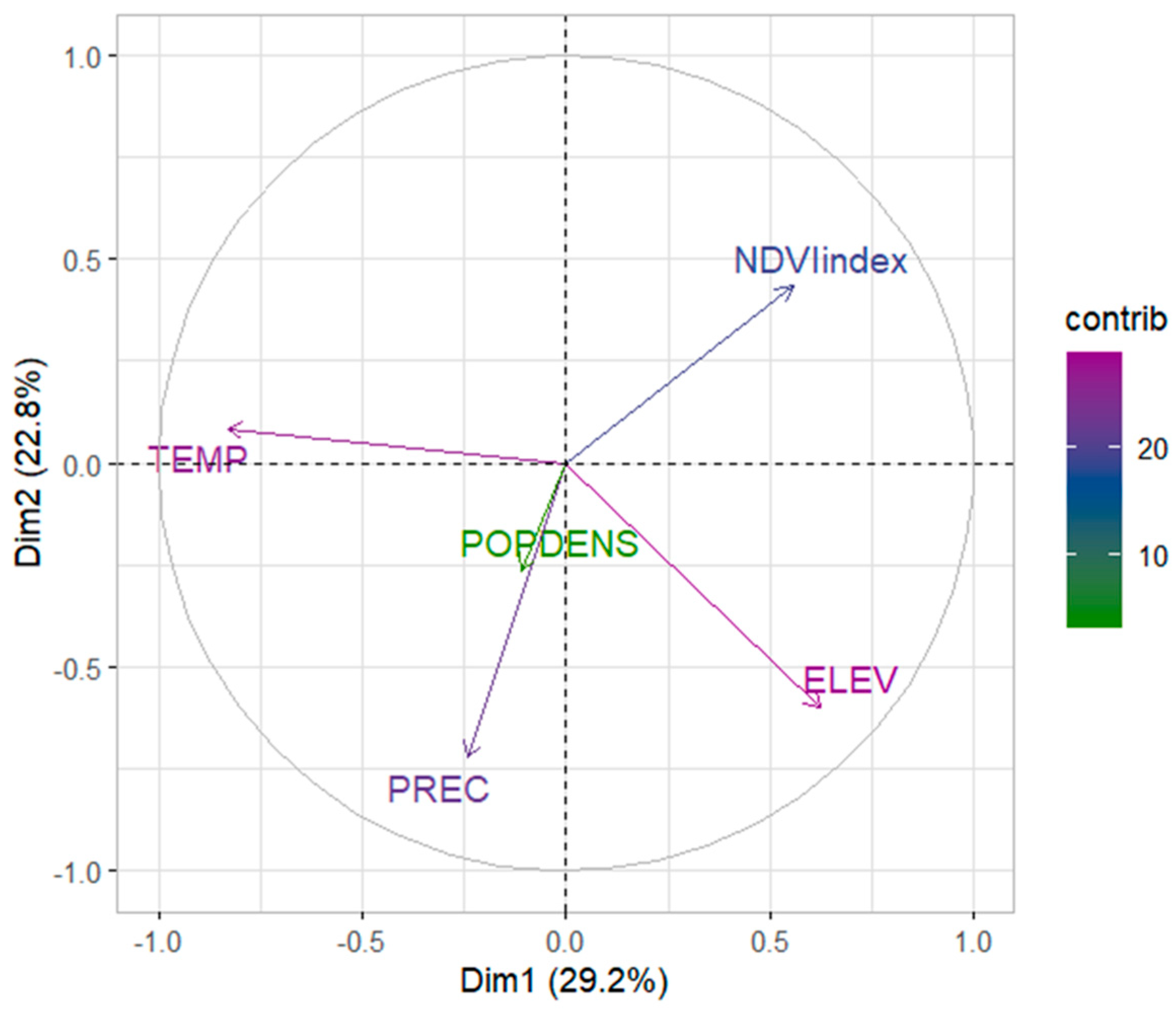
| 2016 | |||||||||||
|---|---|---|---|---|---|---|---|---|---|---|---|
| Amphibians & Reptiles | Birds | Mammals | |||||||||
| Road | Type | Lenght | RK/km | RK/day | RK/Month | RK/km | RK/day | RK/Month | RK/km | RK/day | RK/Month |
| Carretera Estatal Jonuta-Frontera | State | 35.484 | 0.11 | ||||||||
| Carretera Estatal San marcos-Palizada | State | 46.167 | 0.09 | 0.10 | 3.06 | 0.09 | 0.03 | 0.82 | 0.32 | 0.10 | 3.06 |
| Carretera Estatal Temo-Tila | State | 40.26 | 0.10 | ||||||||
| Carretera Estatal Tenosique-El Ceibo | State | 41.54 | 0.10 | 0.04 | 1.22 | 0.07 | 0.02 | 0.61 | 0.10 | 0.03 | 0.82 |
| Carretera Estatal Zapatero (Jalapa-Jonuta) | State | 37.34 | 0.11 | ||||||||
| Carretera Federal 186 Villahermosa-Chetumal | Federal | 252.8 | 0.02 | 0.09 | 2.65 | 0.08 | 0.14 | 4.29 | 0.22 | 0.37 | 11.43 |
| Carretera Federal 203 Emiliano Zapata-Tenosique | Federal | 67.97 | 0.06 | 0.09 | 0.05 | 0.12 | 0.05 | 1.63 | 0.34 | 0.15 | 4.69 |
| Carretera 243 Salto de Agua | State | 40.61 | 0.10 | ||||||||
| Carretera Federal 259 Sabancuy-Escarcega | Federal | 52.386 | 0.08 | 0.05 | 1.43 | 0.36 | 0.13 | 3.88 | 0.57 | 0.20 | 6.12 |
| Carrtera Balancan | State | 21.31 | 0.19 | 0.06 | 1.84 | 0.05 | 0.01 | 0.20 | 0.80 | 0.11 | 3.27 |
| Carretera Estatal Jonuta-Palizada | Federal | 11.45 | 0.35 | 0.03 | 0.82 | 0.17 | 0.01 | 0.41 | 0.17 | 0.01 | 0.41 |
| 2023 | |||||||||||
| Amphibians & Reptiles | Birds | Mammals | |||||||||
| Road | Type | Lenght | RK/km | RK/day | RK/Month | RK/km | RK/day | RK/Month | RK/km | RK/day | RK/Month |
| Carretera Estatal Jonuta-Frontera | State | 35.484 | 0.28 | 0.04 | 1.22 | 0.08 | 0.01 | 0.34 | 0.23 | 0.03 | 0.90 |
| Carretera Estatal San marcos-Palizada | State | 46.167 | |||||||||
| Carretera Estatal Temo-Tila | State | 40.264 | 0.02 | 0.00 | 0.11 | 0.15 | 0.02 | 0.67 | |||
| Carretera Estatal Tenosique-El Ceibo | State | 41.535 | |||||||||
| Carretera Estatal Zapatero (Jalapa-Jonuta) | State | 37.335 | 0.16 | 0.02 | 0.67 | 0.08 | 0.01 | 0.34 | 0.19 | 0.03 | 0.79 |
| Carretera Federal 186 Villahermosa-Chetumal | Federal | 252.818 | 0.00 | 0.00 | 0.11 | 0.01 | 0.01 | 0.22 | 0.04 | 0.04 | 1.12 |
| Carretera Federal 203 Emiliano Zapata-Tenosique | Federal | 67.965 | 0.03 | 0.01 | 0.22 | 0.15 | 0.04 | 1.12 | |||
| Carretera 243 Salto de Agua | State | 40.608 | 0.07 | 0.01 | 0.34 | 0.25 | 0.04 | 1.12 | |||
| Carretera Federal 259 Sabancuy-Escarcega | Federal | 52.386 | |||||||||
| Carrtera Balancan | State | 21.312 | |||||||||
| Carretera Estatal Jonuta-Palizada | Federal | 11.452 | |||||||||
Disclaimer/Publisher’s Note: The statements, opinions and data contained in all publications are solely those of the individual author(s) and contributor(s) and not of MDPI and/or the editor(s). MDPI and/or the editor(s) disclaim responsibility for any injury to people or property resulting from any ideas, methods, instructions or products referred to in the content. |
© 2025 by the authors. Licensee MDPI, Basel, Switzerland. This article is an open access article distributed under the terms and conditions of the Creative Commons Attribution (CC BY) license (https://creativecommons.org/licenses/by/4.0/).
Share and Cite
Buitrago-Torres, D.L.; Pozo-Montuy, G.; Buitrago-Marulanda, B.B.; Frías-Aguilar, J.R.; Mayo Merodio, M.A. Wildlife-Vehicle Collisions as a Threat to Vertebrate Conservation in a Southeastern Mexico Road Network. Wild 2025, 2, 24. https://doi.org/10.3390/wild2030024
Buitrago-Torres DL, Pozo-Montuy G, Buitrago-Marulanda BB, Frías-Aguilar JR, Mayo Merodio MA. Wildlife-Vehicle Collisions as a Threat to Vertebrate Conservation in a Southeastern Mexico Road Network. Wild. 2025; 2(3):24. https://doi.org/10.3390/wild2030024
Chicago/Turabian StyleBuitrago-Torres, Diana L., Gilberto Pozo-Montuy, Brandon Brand Buitrago-Marulanda, José Roberto Frías-Aguilar, and Mauricio Antonio Mayo Merodio. 2025. "Wildlife-Vehicle Collisions as a Threat to Vertebrate Conservation in a Southeastern Mexico Road Network" Wild 2, no. 3: 24. https://doi.org/10.3390/wild2030024
APA StyleBuitrago-Torres, D. L., Pozo-Montuy, G., Buitrago-Marulanda, B. B., Frías-Aguilar, J. R., & Mayo Merodio, M. A. (2025). Wildlife-Vehicle Collisions as a Threat to Vertebrate Conservation in a Southeastern Mexico Road Network. Wild, 2(3), 24. https://doi.org/10.3390/wild2030024








